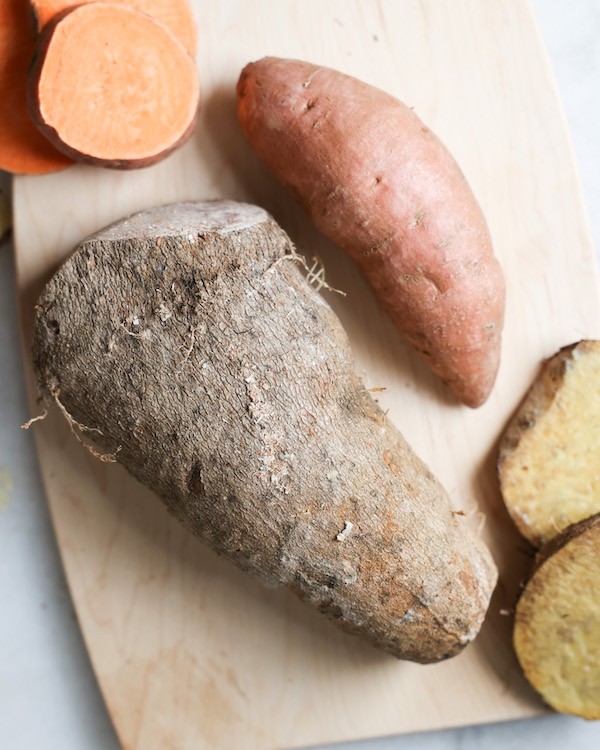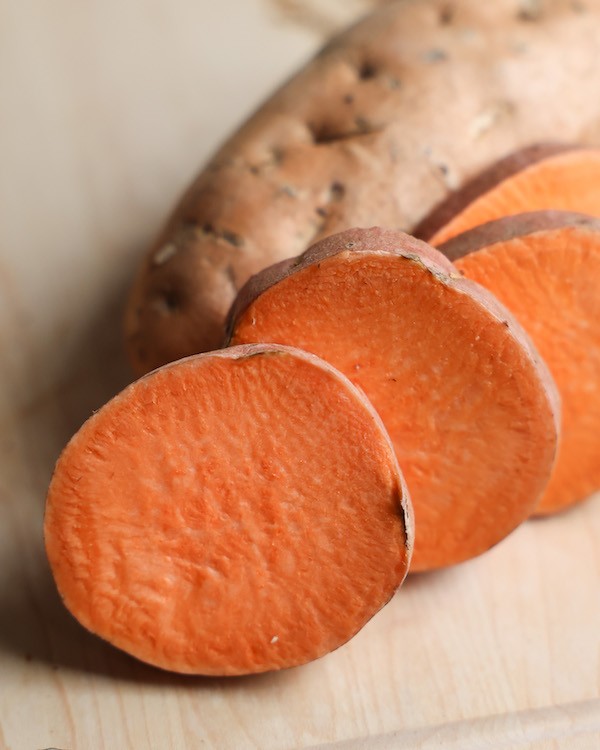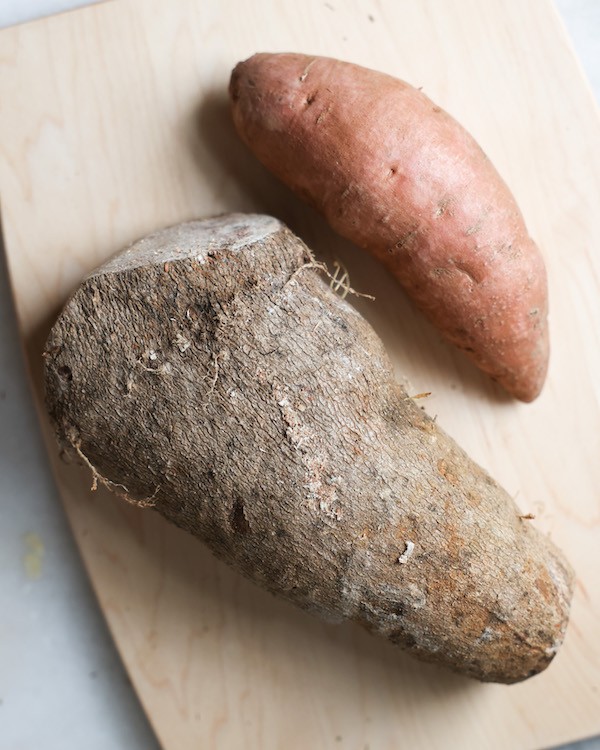Sweet potatoes and yams are often used interchangeably, causing widespread confusion, but did you know they are not the same? At WHY.EDU.VN, we’re here to clear up the mystery behind this common mix-up. This article dives deep into the real differences between sweet potatoes and yams, exploring their origins, nutritional values, and culinary uses, and provides clarity on the “yam” misnomer, shedding light on root vegetable varieties and sweet potato nutrition.
1. Are Yams and Sweet Potatoes The Same Thing?
No, yams and sweet potatoes are distinctly different vegetables. While they may appear similar in some grocery stores, their origins, characteristics, and uses vary significantly.
1.1. What Are True Yams?
True yams belong to the Dioscorea genus and are tubers native to Africa and Asia. They feature rough, bark-like skin and flesh that ranges from white to yellowish. Yams are a dietary staple in many African, Caribbean, and Latin American countries. They have a mild, starchy flavor and can grow quite large.
1.2. What Are Sweet Potatoes?
Sweet potatoes are root vegetables that belong to the morning glory family (Ipomoea batatas). Native to Central and South America, they have smooth skin that can be orange, grey, or purple, with flesh that ranges from white to orange or even bright purple. Sweet potatoes are known for their sweet flavor and are widely used in both savory and sweet dishes.
2. The Great Misunderstanding: Why the Confusion?
The mislabeling of sweet potatoes as “yams” primarily occurs in North America, particularly in the United States. Here’s a deeper look at the historical and marketing factors contributing to this confusion:
2.1. Historical Context: A Matter of Remembrance
One theory suggests that enslaved Africans, upon seeing sweet potatoes, referred to them as “yams” because they resembled the yams they were familiar with in their native lands. The name “yam” (derived from the African word “nyami” or “name”) stuck, and the association persisted over time.
2.2. Marketing Strategy: Differentiating Varieties
Another explanation involves marketing tactics used by sweet potato growers. When orange-fleshed sweet potatoes were introduced to the American market, growers wanted to distinguish them from the existing white-fleshed varieties. They adopted the name “yam” to differentiate their product, leading to widespread misidentification.
3. Key Differences Between Sweet Potatoes and Yams
| Feature | Sweet Potato | Yam |
|---|---|---|
| Origin | Central and South America | Africa and Asia |
| Family | Morning glory family (Ipomoea batatas) | Dioscorea genus |
| Skin | Smooth, thin | Rough, bark-like, thick |
| Flesh Color | White, orange, purple | White, yellowish |
| Texture | Moist, tender | Dry, starchy |
| Flavor | Sweet | Mild, not very sweet |
| Size | Smaller, more uniform | Larger, more variable |
| Common Usage | Both savory and sweet dishes | Primarily savory dishes |
| Availability | Widely available in American grocery stores | Primarily found in specialty stores |
| Growing Region | Temperate climates, Southern United States | Tropical climates |



4. Nutritional Comparison: Sweet Potatoes vs. Yams
Both sweet potatoes and yams offer valuable nutrients, making them excellent additions to a balanced diet. However, they have different nutritional profiles.
4.1. Sweet Potato Nutritional Benefits
Sweet potatoes are rich in:
- Vitamin A: High in beta-carotene, which the body converts to vitamin A, essential for vision and immune function.
- Vitamin C: An antioxidant that supports immune health and skin elasticity.
- Fiber: Promotes digestive health and helps regulate blood sugar levels.
- Potassium: Important for maintaining healthy blood pressure and heart function.
4.2. Yam Nutritional Benefits
Yams are a good source of:
- Copper: Essential for energy production, iron metabolism, and brain function.
- Potassium: Helps maintain fluid balance and supports nerve and muscle function.
- Fiber: Aids in digestion and helps control cholesterol levels.
- Manganese: Important for bone health, metabolism, and antioxidant function.
4.3. Nutritional Data Comparison
| Nutrient | Sweet Potato (1 cup, baked) | Yam (1 cup, boiled) |
|---|---|---|
| Calories | 180 | 157 |
| Carbohydrates | 41.4 grams | 37 grams |
| Fiber | 6.6 grams | 5 grams |
| Sugar | 12.7 grams | 0.5 grams |
| Protein | 4 grams | 2 grams |
| Vitamin A | 922 mcg | 3 mcg |
| Vitamin C | 39.2 mg | 18.4 mg |
| Potassium | 855 mg | 816 mg |
| Copper | 0.2 mg | 0.3 mg |
Source: USDA FoodData Central
5. Culinary Uses: Exploring Sweet Potato and Yam Recipes
Both sweet potatoes and yams are versatile ingredients that can be used in a variety of dishes.
5.1. Sweet Potato Culinary Applications
Sweet potatoes shine in both sweet and savory dishes:
- Baked Sweet Potatoes: A simple and nutritious side dish.
- Sweet Potato Fries: A healthier alternative to regular fries.
- Sweet Potato Pie: A classic dessert, especially popular during Thanksgiving.
- Sweet Potato Soups: Creamy and comforting, often spiced with ginger and cinnamon.
- Roasted Sweet Potatoes: Enhanced with herbs like rosemary or thyme.
5.2. Yam Culinary Applications
Yams are more commonly used in savory dishes:
- Pounded Yam (Iyan): A West African staple made by pounding boiled yams into a smooth, dough-like consistency.
- Yam Porridge: A hearty and flavorful dish cooked with vegetables and spices.
- Roasted Yams: Served as a side dish, often seasoned with herbs and spices.
- Yam Stews: Added to stews for their starchy texture and mild flavor.
6. How to Cook Sweet Potatoes and Yams
Both sweet potatoes and yams are easy to cook, but their cooking methods may vary slightly to highlight their unique textures and flavors.
6.1. Cooking Sweet Potatoes
Sweet potatoes are incredibly versatile and can be cooked in numerous ways:
- Baking: Preheat the oven to 400°F (200°C), poke holes in the sweet potato with a fork, and bake for 45-60 minutes until soft.
- Boiling: Peel and cube the sweet potato, then boil in water until tender, about 15-20 minutes.
- Steaming: Steam peeled and cubed sweet potatoes for about 15-20 minutes until tender.
- Microwaving: Poke holes in the sweet potato and microwave on high for 5-8 minutes, flipping halfway through.
- Air Frying: Cut into fries, toss with oil and spices, and air fry at 400°F (200°C) for 15-20 minutes, shaking halfway through.
- Instant Pot: Place sweet potatoes on a trivet with 1 cup of water in the Instant Pot and cook on high pressure for 12-15 minutes, followed by a natural pressure release.
6.2. Cooking Yams
Yams are also easy to cook, but they are often boiled or added to stews to take advantage of their starchy texture:
- Boiling: Peel and cube the yam, then boil in water until tender, about 20-25 minutes.
- Roasting: Peel and cube the yam, toss with oil and spices, and roast at 400°F (200°C) for 25-30 minutes until tender and slightly caramelized.
- Stewing: Add cubed yams to stews and soups for a hearty and filling addition.
7. Exploring Different Varieties of Sweet Potatoes
While true yams may be harder to find in mainstream American grocery stores, you’ll likely encounter several varieties of sweet potatoes. Here are some of the most common:
7.1. Jewel Sweet Potatoes
- Skin: Light orange
- Flesh: Light orange
- Texture: High moisture content, creamy
- Flavor: Sweet
7.2. Garnet Sweet Potatoes
- Skin: Dark orange to reddish
- Flesh: Orange
- Texture: High moisture content, tender
- Flavor: Sweet
7.3. Beauregard Sweet Potatoes
- Skin: Darker orange
- Flesh: Darker orange
- Texture: Starchier, but still moist
- Flavor: Sweet
7.4. Asian or Caribbean Sweet Potatoes
- Skin: Purplish
- Flesh: Yellowish-white
- Texture: Very starchy
- Flavor: Sweet
7.5. Okinawan Sweet Potatoes (Purple Yams)
- Skin: Greyish-darker
- Flesh: Bright purple
- Texture: Starchy
- Flavor: Very sweet
7.6. Stokes Purple Sweet Potatoes
- Skin: Purple
- Flesh: Purple
- Texture: Varies, can be slightly drier
- Flavor: Sweet
8. Delicious Sweet Potato Recipes to Try
Sweet potatoes are incredibly versatile and can be used in a wide range of recipes. Here are some favorites to get you started:
8.1. Sweet Potato Fries
Ingredients:
- 2 large sweet potatoes, peeled and cut into fries
- 2 tablespoons olive oil
- 1 teaspoon paprika
- 1/2 teaspoon garlic powder
- Salt and pepper to taste
Instructions:
- Preheat oven to 400°F (200°C).
- Toss sweet potato fries with olive oil, paprika, garlic powder, salt, and pepper.
- Spread fries in a single layer on a baking sheet.
- Bake for 20-25 minutes, flipping halfway through, until golden brown and tender.
8.2. Sweet Potato Pie
Ingredients:
- 1 baked sweet potato, mashed
- 1 can (14 oz) sweetened condensed milk
- 2 large eggs
- 1 teaspoon vanilla extract
- 1/2 teaspoon ground cinnamon
- 1/4 teaspoon ground nutmeg
- 1 pie crust
Instructions:
- Preheat oven to 350°F (175°C).
- In a large bowl, combine mashed sweet potato, sweetened condensed milk, eggs, vanilla extract, cinnamon, and nutmeg.
- Pour mixture into pie crust.
- Bake for 45-50 minutes, or until set.
- Let cool completely before serving.
8.3. Sweet Potato and Black Bean Chili
Ingredients:
- 1 tablespoon olive oil
- 1 onion, chopped
- 2 cloves garlic, minced
- 1 red bell pepper, chopped
- 1 sweet potato, peeled and cubed
- 1 can (15 oz) black beans, rinsed and drained
- 1 can (14.5 oz) diced tomatoes, undrained
- 1 cup vegetable broth
- 1 tablespoon chili powder
- 1 teaspoon cumin
- Salt and pepper to taste
Instructions:
- Heat olive oil in a large pot over medium heat.
- Add onion and cook until softened, about 5 minutes.
- Add garlic and red bell pepper and cook for another 3 minutes.
- Stir in sweet potato, black beans, diced tomatoes, vegetable broth, chili powder, cumin, salt, and pepper.
- Bring to a boil, then reduce heat and simmer for 20-25 minutes, or until sweet potato is tender.
9. Exploring Yam Recipes
While sweet potatoes get much of the spotlight in North America, yams are a staple in many other cultures. Here are a few yam-based recipes to explore:
9.1. Pounded Yam (Iyan)
Pounded yam is a West African dish made from boiled yams that are pounded into a smooth, elastic dough. It is often served with soups and stews.
9.2. Yam Porridge
Yam porridge is a hearty and flavorful dish made with yams, vegetables, and spices. It is a popular dish in many African countries.
9.3. Jamaican Yam and Saltfish
This dish combines boiled yams with salt cod, onions, peppers, and spices. It’s a savory and filling meal often enjoyed for breakfast or dinner.
10. Frequently Asked Questions (FAQs) About Sweet Potatoes and Yams
10.1. Are all orange-fleshed sweet potatoes called yams?
No, not all orange-fleshed sweet potatoes are yams. In the United States, the term “yam” is often used to describe sweet potatoes with orange flesh, but true yams are a different vegetable altogether.
10.2. Can I substitute sweet potatoes for yams in recipes?
In most American recipes that call for “yams,” sweet potatoes can be used as a substitute. However, keep in mind that the flavor and texture will be slightly different.
10.3. Where can I find true yams in the United States?
True yams can be found in specialty stores, such as African or Caribbean markets. They are less common in mainstream grocery stores.
10.4. Are sweet potatoes healthier than yams?
Both sweet potatoes and yams are nutritious, but sweet potatoes are higher in vitamin A and vitamin C, while yams are higher in copper.
10.5. How should I store sweet potatoes and yams?
Store sweet potatoes and yams in a cool, dark, and dry place. Avoid storing them in the refrigerator, as this can affect their flavor and texture.
10.6. What are the health benefits of eating sweet potatoes?
Sweet potatoes are rich in vitamins, minerals, and antioxidants, which can support immune function, promote healthy vision, and improve digestion.
10.7. What are the health benefits of eating yams?
Yams are a good source of fiber, potassium, and manganese, which can help regulate blood pressure, improve digestion, and support bone health.
10.8. Can sweet potatoes help with weight loss?
Sweet potatoes are a good source of fiber, which can help you feel full and satisfied, potentially aiding in weight loss.
10.9. Are sweet potatoes good for people with diabetes?
Sweet potatoes have a lower glycemic index than regular potatoes, making them a better option for people with diabetes. However, it’s important to monitor portion sizes.
10.10. How can I tell if a sweet potato is ripe?
A ripe sweet potato should be firm to the touch with smooth, unblemished skin. Avoid sweet potatoes with soft spots or bruises.
11. Conclusion: Embracing the Diversity of Root Vegetables
While the terms “sweet potato” and “yam” are often used interchangeably, understanding the true differences between these vegetables can enrich your culinary experiences and nutritional knowledge. Sweet potatoes, with their vibrant colors and sweet flavors, and yams, with their starchy texture and mild taste, each offer unique benefits and culinary possibilities.
Whether you’re baking a classic sweet potato pie or exploring the flavors of pounded yam, these root vegetables provide a delicious and nutritious way to enhance your diet. At WHY.EDU.VN, we’re committed to providing you with accurate and insightful information to help you make informed choices about the foods you eat.
Still curious about the differences between root vegetables, or have other burning questions? Visit WHY.EDU.VN, located at 101 Curiosity Lane, Answer Town, CA 90210, United States, or contact us via WhatsApp at +1 (213) 555-0101. Our team of experts is ready to provide clear, reliable answers to all your questions. Don’t let confusion hold you back—explore the world of knowledge with why.edu.vn.